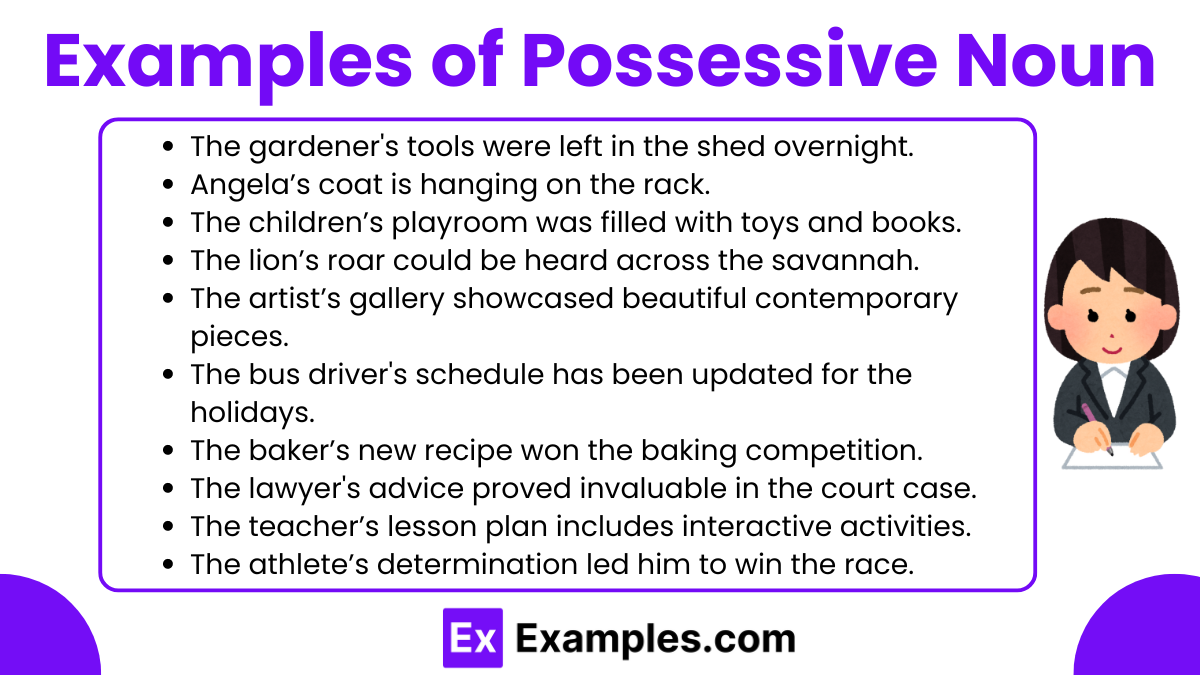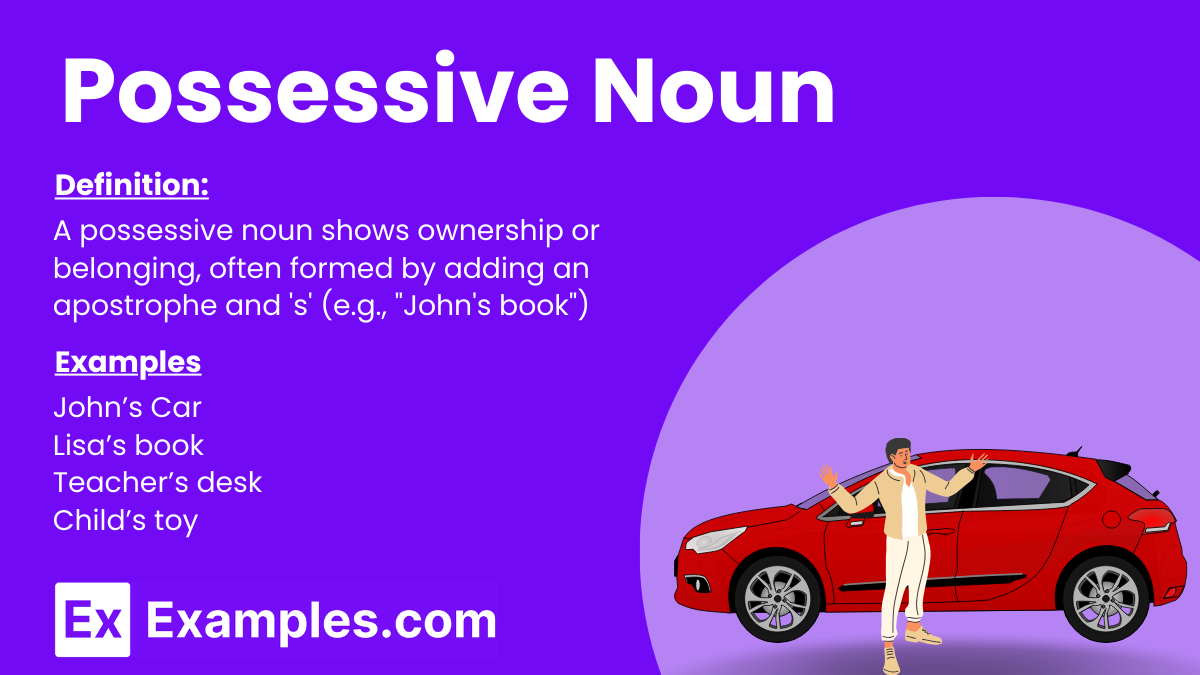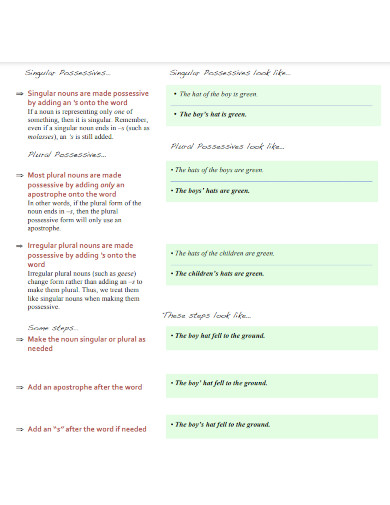30+ Possessive Noun Examples
A possessive noun is a type of noun that shows ownership or possession. It tells us that something belongs to someone or something else. We usually form possessive nouns by adding an apostrophe and an “s” to the end of a noun. For example, in the phrase “Sarah’s book,” the word “Sarah’s” is a possessive noun, indicating that the book belongs to Sarah. If the noun is plural and already ends in an “s,” we simply add an apostrophe at the end, like in “dogs’ bones,” which shows that the bones belong to multiple dogs. This simple modification helps clarify who or what owns something in our sentences.
What are Possessive Nouns?
Types of Possessive Noun
- Singular Possessive Nouns: These are used when one person, place, or thing owns something else. To form a singular possessive, you add an apostrophe followed by ‘s’ to the noun. For example, in “Sarah’s hat,” the hat belongs to Sarah.
- Plural Possessive Nouns: This type is used when more than one person, place, or thing has ownership. If the plural noun already ends in ‘s’, you simply add an apostrophe at the end. For example, “teachers’ lounge” indicates a lounge that belongs to multiple teachers. If the plural noun does not end in ‘s’, you add an apostrophe followed by ‘s’, like “children’s playground,” indicating a playground for children.
Examples of Possessive Noun
- John’s bike – The bike that belongs to John.
- Lisa’s book – The book owned by Lisa.
- Mom’s recipe – The recipe that belongs to Mom.
- Teacher’s desk – The desk that belongs to the teacher.
- Doctor’s appointment – The appointment for the doctor.
- Bird’s nest – The nest built by a bird.
- Child’s toy – A toy that belongs to a child.
- Boss’s order – The order given by the boss.
- Cat’s whiskers – The whiskers on a cat.
- Man’s hat – The hat owned by a man.
- Dogs’ leashes – The leashes belonging to multiple dogs.
- Teachers’ lounge – The lounge for teachers.
- Players’ uniforms – The uniforms worn by the players.
- Sisters’ bedroom – The bedroom shared by sisters.
- Friends’ gathering – A gathering hosted by friends.
- Doctors’ conference – A conference for doctors.
- Authors’ books – Books written by various authors.
- Cars’ keys – The keys for various cars.
- Students’ assignments – Assignments to be completed by students.
- Managers’ meeting – A meeting for the managers.
- Children’s playground – The playground designed for children.
- Women’s club – A club for women.
- Men’s shoes – Shoes designed for men.
- People’s choice – The choice preferred by the majority of people.
- Mice’s holes – Holes inhabited by mice.
- Oxen’s yoke – The yoke used by oxen.
- Geese’s migration – The migration path followed by geese.
- Alumni’s reunion – A reunion attended by alumni.
- Sheep’s wool – Wool sheared from sheep.
- Children’s books – Books written specifically for children.
Examples of Possessive Noun in Sentences

- Tom’s laptop is faster than mine.
- The cat’s tail twitched as it slept.
- My parents’ house has a beautiful garden.
- The children’s homework was completed on time.
- Jessica’s phone rang during the meeting.
- The teachers’ lounge was renovated last summer.
- The Smiths’ vacation photos were stunning.
- The birds’ feeder needs refilling.
- The company’s profits have increased this quarter.
- The dog’s barking scared the postman.
- The gardener’s tools were left in the shed overnight.
- Angela’s coat is hanging on the rack.
- The children’s playroom was filled with toys and books.
- The lion’s roar could be heard across the savannah.
- The artist’s gallery showcased beautiful contemporary pieces.
- The bus driver’s schedule has been updated for the holidays.
- The baker’s new recipe won the baking competition.
- The lawyer’s advice proved invaluable in the court case.
- The teacher’s lesson plan includes interactive activities.
- The athlete’s determination led him to win the race.
- The baby’s first steps brought joy to the whole family.
- The chef’s special tonight is seafood pasta.
- The traveler’s passport was stamped in six different countries.
- The musician’s guitar was signed by famous artists.
- The author’s new book received rave reviews.
- The professor’s lecture was insightful and engaging.
- The photographer’s lens captures stunning landscapes.
- The cat’s meow alerted them to her presence.
- The director’s cut of the film includes additional scenes.
- The investor’s portfolio has diversified assets for better returns.
Rules for Possessive Noun
- Add an Apostrophe + ‘s’ for Singular Nouns: To show possession for most singular nouns, add an apostrophe followed by ‘s’. For example:
- The girl’s bicycle shows that the bicycle belongs to the girl.
- Use Only an Apostrophe for Plural Nouns Ending in ‘s’: For plural nouns that already end in ‘s’, just add an apostrophe after the ‘s’. For example:
- The teachers’ lounge indicates a lounge used by the teachers.
- Add an Apostrophe + ‘s’ for Plural Nouns Not Ending in ‘s’: If a plural noun does not end in ‘s’, treat it like a singular noun and add an apostrophe followed by ‘s’. For example:
- The children’s playground refers to a playground for children.
- For Names Ending in ‘s’, Both Forms are Common: For singular proper names ending in ‘s’, it’s acceptable to add just an apostrophe or an apostrophe and ‘s’. For example:
- James’ book or James’s book are both correct.
- Use Possessive Nouns for Living Things: Generally, use possessive forms with living things (people, animals). For inanimate objects, consider using “of” to show ownership. For example:
- The leg of the table is better than the table’s leg.
1. Using Possessive Nouns Template
How to Use Possessive Noun
Using possessive nouns correctly allows you to clearly express ownership in your sentences.
Identify the Owner
Start by determining who or what owns something. The owner could be a person, an animal, or a group.
Add the Correct Form of Apostrophe
Depending on whether the noun is singular, plural, or ends in ‘s’, you’ll use different forms of apostrophes:
Singular nouns not ending in ‘s’: Add an apostrophe plus ‘s’ (e.g., the dog’s leash).
Singular nouns ending in ‘s’: Both an apostrophe and ‘s’ (e.g., Chris’s book) or just an apostrophe (e.g., Chris’ book) are acceptable.
Plural nouns ending in ‘s’: Add only an apostrophe (e.g., the dogs’ bones).
Plural nouns not ending in ‘s’: Add an apostrophe plus ‘s’ (e.g., the children’s toys).Place the Noun Correctly in the Sentence
:The possessive noun typically comes before the thing it owns. For example, in “Maria’s car,” “Maria’s” is the possessive noun showing ownership of “car.”
Avoid Double Possessives
Generally, avoid using a possessive form with possessive pronouns or articles that already express possession. For instance, instead of saying “my friend’s car,” use “my friend’s car.”
Tips for Using for Possessive Noun
- Always Use the Correct Apostrophe Placement: Ensure you place the apostrophe correctly depending on whether the noun is singular or plural. This small punctuation mark is crucial for showing possession accurately.
- Use Possessive Nouns Mainly for Living Things: While possessive forms can be used with inanimate objects, they are best suited to indicate possession related to people and animals. For non-living things, consider using expressions like “the door of the car” instead of “the car’s door” unless the possessive form sounds natural (e.g., “today’s weather”).
- Distinguish Between Its and It’s: Remember that “it’s” is a contraction for “it is” or “it has,” and “its” is a possessive adjective meaning “belonging to it.” This common mistake can change the meaning of your sentence.
- Avoid Double Possessives: Double possessives occur when you use two possessive forms together, which is usually redundant. For example, say “my brother’s friend” instead of “a friend of my brother’s” unless you need to emphasize one of many (e.g., “a friend of my brother’s among many”).
- Keep the Noun Owner Clear: When using possessive nouns, make sure it’s clear who the owner is. Confusion can arise if the sentence is cluttered or the noun and its owner are too far apart.
- Be Consistent with Singular Names Ending in ‘s’: Choose whether to use ‘s or just an apostrophe for names ending in ‘s’ and stick with it throughout your document to maintain consistency.
- Review Plural Forms: Be vigilant about plural possessive forms. If the plural form of the noun does not end in ‘s’, treat it like a singular noun and add ‘s (e.g., children’s, women’s).
How to Identify Possessive Nouns?
Look for a noun with an apostrophe. If it ends with an apostrophe and ‘s’ or just an apostrophe, it likely indicates possession.
How to Explain Possessive Nouns to Kids?
Tell kids that possessive nouns are like a label on a backpack that shows who it belongs to, using an apostrophe and ‘s’ to show ownership.
How to Teach Possessive Nouns to First Graders?
Use examples with common items (e.g., “Sara’s ball” or “dog’s bone”). Show how the apostrophe helps us know who owns what.
How to Teach Possessives in a Fun Way?
Create a game where kids match items to their owners using cards, practice with toys, or create a possessive treasure hunt.
How do you make a noun possessive?
Add an apostrophe and ‘s’ to singular nouns; add an apostrophe after ‘s’ for plural nouns.
How do plural possessives work?
If the plural noun ends in ‘s’, add only an apostrophe. If not, add apostrophe and ‘s’.
How should possessive nouns be used in sentences?
Place the possessive noun before the thing it owns to clearly show ownership.
Are possessive nouns used in formal writing?
Yes, possessive nouns are widely used and accepted in all types of writing.
How do you handle possessive nouns that are plural but do not end in ‘s’?
Add an apostrophe followed by ‘s’, as in “children’s playground” or “women’s rights.”
How do possessive nouns change with irregular plurals?
Irregular plurals like “men” or “children” still take an apostrophe followed by ‘s’, as in “men’s room” and “children’s books.”




